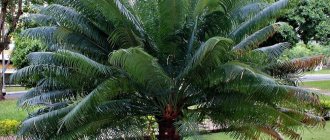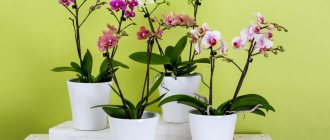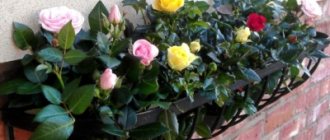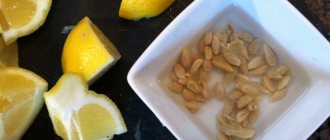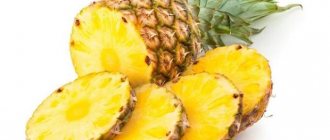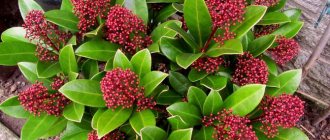Fatsia is known to many as “home chestnut”. It captivates lovers of floriculture with its lush, dense crown and carved large leaves. Despite its impressive size, the flower fits harmoniously into the interior of even small rooms. The plant is one of the designers' favorites. Fatsia is valued not only for its aesthetic qualities, but also for its unpretentiousness to growing conditions.
General characteristics of fatsia
This is a woody plant with large leaves. Their width can sometimes reach 40 cm. The fatsia leaf is very original and beautiful due to its shape in the form of an open five, and has a glossy, bright green color. The height of this representative of the flora in natural conditions is about 4 meters. Indoor flowers require a lot of free space, free arrangement, and only if these conditions are met can they delight you with a chic crown.
The plant belongs to the Araliaceae family and has a single pure species called Japanese fatsia, as well as several varieties (see their names and photos at the end of the article).
Benefits and harms
Fatsia leaves contain many useful substances, alkaloids, and essential oils. In folk medicine they are often used as a stimulant and tonic that increases the body's immunity. The root of the plant is used in the treatment and prevention of diabetes.
At the same time, Fatsia juice is slightly toxic. In people with sensitive skin, it may cause an allergic reaction such as redness, itching or burning. We advise you to always work with the plant wearing rubber gloves, and after work, wash your hands with soap.
Lighting and location
- The green pet loves bright, (not sunny), cool places with a regular supply of fresh air. The place should be slightly shaded, with diffused light;
- An excellent location for the bush is the western or eastern side of the house;
- The variegated Japanese beauty needs sun, and varieties with leaves of the same shade stand well in the shade;
- In summer, an indoor flower can be placed outside, avoiding direct sunlight.
Signs and superstitions
In Japan, since ancient times, Fatsia has been placed on the north side of the home, as it was believed that this plant protects the inhabitants of the house from evil northern spirits.
The Japanese chestnut is usually called the flower of family happiness, as it radiates positive energy and neutralizes negative emotions, improving the mood of household members. In the house where Fatsia grows up, people quarrel less, and harmony and agreement reign in the family.
With good care, Fatsia can grow for a long time and decorate rooms for a wide variety of purposes. This plant is perfect for landscaping spacious rooms and offices; with the help of dense green bushes you can divide an open-plan house into functional zones. For its unpretentiousness, exotic appearance and rapid growth, this eastern guest is so loved not only by flower growers around the world, but also by phyto-designers who often use this flower to decorate modern houses, apartments and offices.
Humidity and watering
- In hot weather, the bush should be watered generously with clean, cool water. By autumn, the amount of water decreases;
- In winter, the “green resident” is watered less often and kept cool;
- When several hours have passed after moistening the soil, remove excess liquid from the pan, otherwise the roots of the bush will rot;
- If the soil dries out, the "southerner" may drop its leaves, and it will be extremely difficult to raise them again. For this purpose, special spacers are made and the leaves are tied horizontally;
- Caring for Fatsia at home involves maintaining high air humidity in your home. Spray the leaves with a spray bottle, if possible, carry out wet cleaning daily, wipe the leaves with a napkin.
PS We wrote about how to humidify the air in a room here.
Possible problems
If a flower is not properly cared for, various problems may arise with its foliage.
- Spots on Fatsia leaves . When the earthen clod dries out, brown spots form on the surface of the foliage. In the worst case, it wilts, and it is extremely difficult to return it to its previous state.
- Fatsia leaves wrinkle . If the air humidity in the room is extremely low, the foliage becomes fragile because of this. If at the same time there is very intense light, then wrinkling of the foliage may occur.
- Fatsia leaves wither . Leaf wilting is observed due to stagnation of fluid in the root system. If this happens constantly, rot may appear on the roots.
Pests
Most often, mealybugs, spider mites, whiteflies and scale insects settle on the bush.
Fatsia or a headache for the grower
Replanting and pruning indoor flowers
Caring for fatsia is not difficult, because it easily tolerates formative pruning for a more luxuriant crown. When pruning a young “southerner”, the top is pinched off. After some time, foliage will appear on the trunk, and new young shoots will appear near the base, which will later serve as cuttings for transplants.
House shrubs are replanted every few years. The new container should be larger than the old one, because the tree-like plant can please you with young trunks. Fatsia is replanted as follows: one-third of the pot is filled with broken shards and expanded clay, and soil mixture is added to the rest.
Transplanting a plant
The flower is replanted once a year in the first two years of life, then once every three to four years. After purchase, Fatsia also needs to be replanted in order to replace the plastic pot with a clay pot and change the substrate. The clay pot is selected in diameter larger than the root system of the flower by 3–4 cm and 5 cm deeper than the previous pot, always with drainage holes.
If there is only one hole, then you can drill several more so that the earthen ball does not become waterlogged.
Pores in a clay pot will allow moisture to evaporate quickly. A deeper container is needed so that the fatsia roots do not grow into the holes and do not suffer during replanting.
Fatsia cuttings
- Propagation by cuttings is carried out in the spring. Rooting at a temperature of 24-26 degrees in moist soil with diffused light occurs very quickly;
- Cuttings 10 cm tall should acquire a certain number of buds that are ready to grow;
- Cover them with a glass jar or film, and plant them in the ground a month after rooting. With this method, voluminous but small shrubs are formed.
Briefly about cultivation
- Flowering: the plant is grown as an ornamental foliage plant.
- Lighting: Variegated varieties need bright, indirect light, while green-leaved varieties thrive in partial shade.
- Temperature: from spring to autumn – 17-21 ºC, in winter – 13-15 ºC. For variegated forms, the lower temperature limit is 16 ºC.
- Watering: during the period of active growth - as soon as the top layer of soil dries, and during a cool winter, you just need to prevent the substrate from drying out completely.
- Humidity: high. Regular spraying and washing of the leaves with a damp sponge is recommended.
- Feeding: during the growing season - every week with mineral or organic fertilizers. During cold wintering, the plant is not fed, and when fatsia is kept warm in winter, fertilizer is applied once a month.
- Pruning: in spring. Some types of fatsia require constant shortening of shoots.
- Replanting: once every three years in spring or early summer.
- Substrate: turf, leaf, humus soil and sand in equal parts.
- Reproduction: cuttings, seeds and layering.
- Pests: whiteflies, scale insects, spider mites and mealybugs.
- Diseases: due to improper care or violation of maintenance conditions, Fatsia develops problems with leaves.
- Properties: the Fatsia japonica plant is poisonous!
Read more about growing Fatsia below.
How to propagate Fatsia by layering
When a flower is properly cared for, its trunk is abundantly covered with foliage. If it becomes bare, the plant is rejuvenated using layering:
- In the spring season, the bark on the trunk covering must be cut;
- Wrap the incision with wet moss, which is soaked in a solution with fertilizers or a phytohormone;
- Wrap with film;
- Make sure that the moss is always damp;
- After a certain time, the first root will appear at the incision site;
- After this, after 2 months, cut off the top with roots and plant in a separate container;
- The top must be cut off slightly below the emerging roots.
Features of seasonal care
Like many ornamental plants, Fatsia prefers to rest in winter. With the onset of cold weather, all life processes slow down and new shoots practically do not appear. Therefore, caring for the crop requires some correction.
Fertilizers are completely stopped in the fall, and watering is significantly reduced. But you can’t completely dry out the soil. It is preferable to place the flowerpot in a cool place. But for variegated forms, the temperature should not fall below +16 degrees. If the fatsia continues to overwinter in the warmth, then it must be sprayed periodically and additional lighting must be provided with fluorescent or LED lamps.
Propagation by seeds
Growing fatsia from seeds is a simple process:
- Place fresh seeds in the soil 10 mm deep. For these purposes, we will take small boxes;
- Soil for seeds: leaf soil, sand and turf (1:1:1);
- We maintain the temperature regime of the ground and surrounding airspace at a temperature of 18 degrees;
- After germination, seedlings are transplanted one at a time into separate pots. Soil for sprouts: turf, humus, sand (2:1:1);
- Place the pots in a bright place.
Botanical description
Fatsia (lat. Fatsia) is a monotypic genus belonging to the Araliaceae family - Fatsia japonica (Japanese fatsia) . Since 1910, a mixture between ivy and Fatsia - Fatshedera - has often been grown at home. House fatsia is often used to decorate pillars, walls and shop windows. The interiors are also decorated. Fatsias growing in pots decorate baskets. The plant can grow up to 1 m in height in just a couple of years if it is properly cared for and constantly fed. To form a beautiful crown, nothing should interfere with the plant.
Pests and diseases of indoor fatsia
Pests that can damage a home flower: whitefly, mealybug, thrips, aphids, scale insects, spider mites.
- When they appear, treat the stem covering and leaves by spraying with fungicides - 3 times, take a break for a few minutes. The best effective way is to use the Actellik product;
- A simple soap solution, sprayed several times a day, will also help.
Ailments of the southern pet:
- Sunburn (a representative of the flora is in direct sunlight): its leaves become wrinkled. Treatment: it is necessary to increase air humidity, make shade for the shrub;
- Lack of moisture: leaves break and dry out. Treatment: abundant watering and “shower” every day in the summer;
- Excess moisture: drooping and soft foliage. How to help: do not water for several days, remove the liquid from the pan;
- Gray rot (the flower is kept in a damp, cold place): the stem rots and turns brown. Treatment: place in a more ventilated area, remove damaged parts.
Caring for Fatsia at home
Fatsia is considered an unpretentious plant. We will tell you about the rules for caring for this shrub at home, and you will see for yourself that it is not difficult.
Purchase and first steps
In the store, choose a small, still young plant that has not had time to grow much. Pay attention to its appearance - the leaves should be healthy, shiny, without visible damage and insects. If the leaves are drooping and drooping, then this is a sign that the plant is unhealthy or is poorly cared for. Returning them to a normal horizontal or elevated position will most likely be difficult or even impossible. Therefore, do not buy such a plant.
If you make a purchase in winter, then do not forget that Fatsia is originally from the tropics, do not freeze it on the way home. We advise you to wrap the pot in several layers of polyethylene in a warm room so that the resulting “bag” is filled with warm air. After arriving at the place, do not remove the film for 2-3 hours - let the flower adapt to the new conditions. Then once again carefully inspect all its leaves for the presence of pests, and at the slightest suspicion, wash them with warm soapy water. One and a half to two weeks after purchase, transplant Fatsia into a new, slightly larger pot.
We advise you not to simply transfer the flower to another pot with a lump of earth, but to completely clean the roots from the transport substrate. At the same time, check the condition of the root system and remove broken and rotten roots, if any.
Soil and pot
The plant is suitable for soil rich in nutrients. But it must be loose, light and water-permeable. A ready-made universal substrate from the store for decorative foliage plants is suitable.
You can also prepare the substrate yourself. To do this, take 2 parts of turf soil and 1 part each of leaf humus, peat and sand. Acidity should be slightly acidic or normal (pH from 5.0 to 7.0).
Choose a clay or ceramic pot, which is more stable for a large plant, with drainage holes in the bottom. For a young flower, the pot should be deep, but not very wide, 2–3 cm wider than the root system. At the bottom of the pot there should be a layer of drainage made of large pieces of expanded clay, brick or pebbles, occupying 1/3 of the height of the pot.
Support
In the wild, Fatsia grows without support. But at home he often needs support. The trunk of the plant is quite thin and is not always able to support a massive crown. You will have to take care of support in advance before the flower bends to one side. Then it will be difficult to correct the situation. Fatsia's shoots are not so elastic, and if you notice that the stem begins to deviate from the vertical, take immediate action. The support for the flower can be bamboo sticks or posts wrapped in coconut fiber. You can buy them in flower shops or make them yourself. The main thing is that this support is stable and does not interfere with the growth of leaves.
Fatsia transplant
Since the plant develops and grows quite quickly, especially at a young age, it should be transplanted annually, in the spring, into a new, slightly larger pot. Adult specimens need to be replanted less frequently, once every two to three years, and then only on the condition that its roots have begun to peek out of the drainage holes. In the intervals between transplants, we advise you to simply replace the top layer of soil in the pot with fresh substrate in the spring. Choose a pot 3–5 cm wider and deeper than the old one. Transplantation is carried out by transferring the plant along with a lump of earth into a new pot, prepared according to all the rules. Then carefully remove the top part of the soil, and pour new substrate in its place and in all free spaces on the sides of the pot. Then water.
If you are transplanting a diseased flower in order to remove rotten roots, then the soil from the roots should be carefully shaken off, rotten, dry or broken roots should be cut off. Sprinkle the cut areas with crushed coal. Only then can the plant be placed in a new pot and covered with fresh substrate.
Top dressing
From early spring to October, during the period of active growth of Fatsia, it needs to be regularly fed with fertilizers with a high nitrogen content. Complex fertilizers for decorative foliage plants in liquid form are suitable. Apply one dose of fertilizer during or after regular watering every 10-12 days. In winter, Fatsia should not be fed, even if the plant is in an active state and winters in a warm room.
Lighting
As we wrote earlier, the indoor flower Fatsia is able to adapt to any lighting. It can even grow with great success under artificial light. Just try to keep the lighting more or less stable throughout the year. Then, having adapted to a certain lighting intensity, the flower will grow and develop normally. This gives it a significant advantage among similar indoor plants. It will grow quickly in any location and retain the attractive shiny color of its leaves.
Variegated forms and Fatsia varieties need stronger lighting. The bright sun will not burn Fatsia's dense leaves, but extreme heat can cause them to become lethargic. It is better to stick to diffused lighting or openwork partial shade.
But we recommend placing adult plants of impressive size in the shade - their attractiveness will remain, but growth will noticeably slow down
Temperature
Fatsia does not have any special requirements for ambient temperature. It is suitable for a wide range of temperatures, from 18 to 25 degrees. Higher temperatures will not harm the flower if it is shaded from direct sunlight and properly watered. But it will be better if the ambient temperature is moderate, then the flower will look gorgeous.
In winter, if you send a flower to forced rest, the temperature can be reduced to 15 degrees. heat (variegated varieties up to 18 degrees). But hibernation is not vital for a flower; some gardeners just don’t want the extra hassle of providing the flower with additional lighting. When wintering under normal indoor conditions, Fatsia will have to be placed closer to the south window and turn on a fluorescent lamp or phytolamp in the evening for two to four hours after it gets dark outside the window.
Fatsia loves fresh air and is not at all afraid of drafts in the summer. Therefore, you can take it out to the balcony or veranda all summer long with shelter from precipitation and direct sunlight.
Watering
The watering regime for Fatsia japonica is the most important point in the rules for caring for the plant. The flower loves abundant watering and moist soil. If you do not water its substrate in time and discover this when its leaves droop and droop, most likely, abundant watering may not bring them back to life. At the very least, you will have to install a support for its drooping leaves in order to somehow give them a horizontal position.
However, the flower also reacts negatively to excessive watering - the shoots will begin to turn yellow, the leaves will become soft and fall off, and the roots will rot. This is why it is so important to keep soil moisture stable.
In the spring-summer period of the year, water when the top layer of soil dries a couple of cm deep. In autumn, gradually reduce the volume of water, but it is strictly forbidden to allow the earthen clod to dry out completely.
This may be interesting: Scindapsus - a tropical vine in your home
Water the flower only with settled water at room temperature until water appears from the drainage holes of the pot. After some time, be sure to remove excess water from the pan.
If the flower is not sent to rest in a cooler room in winter, then each subsequent watering should be only after the soil in the pot has dried almost half. Water generously until water appears in the pan. Drain off excess water. If the room is cool, then it is better to slightly warm up the water for irrigation.
Humidity and spraying
Fatsia has rather large leaves that actively evaporate moisture. Therefore, the flower does not like too dry air. The humidity in the room should be normal or slightly higher. Otherwise, the tips of the leaves may dry out, which will spoil the appearance of the flower. It is not necessary to install air humidifiers or place the pot in a tray with wet expanded clay. Regular ventilation of the room and regular spraying of the surrounding air and leaves are sufficient.
Fatsia likes her leaves to be sprayed daily with soft water at room temperature. Even in winter, if the room is hot, spray the flower at least a couple of times a week. But you should not spray in a cool room.
Bathing
In the hot summer, the flower loves to take a shower. Place the pot in the bathroom, cover the soil with film. Wash the leaves well with cool shower water.
The rest of the time, dust from Fatsia leaves should be removed using a damp cloth, soft cloth or sponge. The cleanliness of the leaves not only gives beauty to its crown, but also provides the plant with breathing and nutrition, and prevents the appearance of parasitic insects.
Crown formation
Fatsia is reluctant to branch on its own, and if left undisturbed, it will grow in the form of a stem with long petioles and large leaves. Over time, the lower ones will inevitably age and die, and the trunk will become bare. You will get a crown on top, like a palm tree. But if you regularly carry out the formation by pinching the tops of the shoots, the lateral buds will begin to develop. They will give new branches, and Fatsia will become a fluffy bush. Pinch back the tops throughout the year. On the eve of spring awakening, perform sanitary pruning, remove weak shoots that have lost their decorative appearance. The flower tolerates this procedure well. Just do it better in the morning so that the sap flow stops in the evening.
Fatsia flowering
Fatsia is grown as an ornamental foliage plant, although it can bloom indoors. Some flower growers believe that its flowering is completely unremarkable, that it only weakens the strength of the flower and spoils its attractive appearance. But others consider Fatsia's flowering to be original.
Fatsia begins to bloom somewhere in mid-autumn, when other indoor plants are already preparing for winter. A complex umbrella inflorescence grows in the center of the bush. It grows up to 30 cm in diameter and consists of smaller, ball-like, white or greenish-cream inflorescences in the form of umbrellas, up to four cm in diameter. Small bisexual flowers consist of an ovary and 5 long stamens. The petals are weakly defined and look like a short wavy border around the core. Against the background of large shiny foliage, the flowers seem airy, lacy, a little like dandelion flowers.
Fatsia berries
After pollination, a fruit is formed in the lower ovary in the form of a small round drupe, half a cm in diameter. These berries, black or dark purple in color, are similar to rowan berries. So the fruits of Fatsia look no less decorative than the leaves. Seeds, however, do not always ripen in them and quickly lose their viability.
Types of fatsia
- Fatsia Lizei (Lizei) - grows in the form of a bush, the leaves cover the stems in a thick layer. The leafy, leathery plate is divided into 4-5 “blades” of a dark emerald hue. The “green resident” is winding and needs support;
- Fatsia Samurai - very similar to Japonica, has leaf plates 30 cm in diameter, in the shape of “lobes-blades” with a glossy surface. The height barely reaches 1.5 meters. It blooms with fragrant, fragrant flowers that have a whitish or greenish tint. The flowers are “umbrellas”, and the fruits are small dark blue berries;
- Fatsia imperia has overly large, shiny glossy leaves that form a dense crown of a tree in the shape of a ball with a diameter of up to 40 cm. The height is measured at 1.5 meters and it blooms rarely;
- Fatsia japonica is another name for the Aralia fatsia flower. It has the shape of a tree with a slightly branched trunk and light brownish bark. The shape of the leaves is round, divided into “lobes - fingers”; parts of the leaves have a serrated edge and a broadly lanceolate shape.
In floriculture, the most popular garden forms of Fatsia japonica are:
- Miseri is a small compact plant with rich green leaves;
- Aureimarginalis – the veins on the leaves have a yellowish tint;
- Fatsia variegata (Variegata) - the edges of the leaf blades of this shrub are painted milky or white.
You can buy fatsia in online flower shops. Its price depends on the height of the specimen and the diameter of the pot. For example, the cost of a plant 50 cm high in a pot with a diameter of 17 cm will be approximately 750 rubles.
Japanese Fatsia: a brief description
Fatsia belongs to the genus of the same name in the Araliaceae family. There are 3 species of this plant in total, and only one of them, Fatsia Japonica, has successfully acclimatized and adapted to home conditions. Japan is considered the birthplace of this plant, but today it can also be found in Taiwan, China and the forests of the Far East.
The small, lush Fatsia tree can grow up to 2 m in height. The crown of the plant is neat, but massive due to the huge number of large leaves measuring 30-35 cm. The leaf blades of the Japanese chestnut are leathery, with a glossy sheen, dissected into several lobes and planted on long petioles. The shape of the leaves on one bush can be heart-shaped, round or dissected into 5-10 lobes. In terms of color, Fatsia's foliage can be solid dark green or variegated with white spots and a border.
The shoots of Japanese chestnut are thin, flexible and under the weight of the leaves they bend in an arc. Therefore, good support is very important for the plant, which will help give the desired shape and will not allow the crown to fall apart.
Why doesn't quince grow?
If you planted a quince, but it did not grow, it means that you made mistakes during planting:
- dug a hole too deep;
- the root collar of the seedling was too deep;
- prepared the wrong soil mixture;
- The shoots were not shortened after planting.
In this case, it is worth replanting the plant, following all the rules.
- The bush may also not grow or bloom due to poor care:
- the plant does not have enough light;
- the soil is alkalized;
- no nitrogen fertilizers are applied;
- creeping shoots are not removed;
- during the formation of the bush, valuable shoots were cut off;
- They didn’t take care of wintering, and the branches froze.
Growing Japanese quince has its own nuances. If the plant is planted correctly and properly cared for, it will grow quickly and bear fruit well. Attentive gardeners are guaranteed an excellent harvest.
Tips for self-propagation of fatsia
You can get a new evergreen plant by planting seeds, cuttings or air layering.
For cuttings at home, with the arrival of spring, cuttings are carried out from the tops of the shoots. The cuttings should have several buds that are ready to develop. Planting is carried out in a sandy-peat substrate, previously slightly moistened. It is necessary to maintain a temperature of 20–26 degrees and then rooting will be successful and fast. After planting, the cuttings must be wrapped in plastic wrap or placed under a cut plastic bottle (glass jar). This will create mini-greenhouse conditions with increased humidity and heat. It is necessary to regularly ventilate the plant daily in the morning and evening for half an hour. When the branches take root and the growth of new leaves is visible, the young fatsias can be transplanted into new large pots with a substrate suitable for further growth. With this propagation method, the bush will be compact and densely leafy.
If the plant's trunk is unsightly exposed, then the aralia can be rejuvenated by planting air layering. In spring, a not very deep cut is made on the stem and then it is wrapped in moistened sphagnum moss, which is impregnated with phytohormones or a solution with nutritional properties (1 gram of complex fertilizer is dissolved in 1 liter of water). From above, this entire structure is wrapped in plastic or cling film. It is necessary to keep the moss moisturized at all times. After several months, root shoots form at the cut site. After this, another two months should pass and you can cut off the top with the roots slightly below their formation and plant them in a separate container with drainage and soil. There is no need to throw away the old trunk, even if there are absolutely no leaves on it. You need to cut it off almost at the root and continue to water and care for it, covering it with moistened sphagnum moss. Very often new shoots develop in its place.
You can also propagate at home by planting seeds. Planting takes place in soil made up of turf soil, leaf and river sand (all parts are equal), poured into pots or planting boxes. Seed material is planted to a depth of 1 cm. For seedlings to emerge, it is necessary to adhere to heat levels of at least 18 degrees. As soon as a pair of true leaves appear on the seedlings, and they have become sufficiently strong, you can carefully transplant one plant at a time into separate 9–11 cm pots, and place the young fatsias in a sufficiently lit place, but without bright rays of the sun.
Conditions of detention
Despite its unpretentiousness and good survival rate, fatsia still requires the creation of certain conditions.
Temperature and humidity
The most favorable temperature for the spring, summer and early autumn periods is considered to be 20–24°.
In most cases, this is normal room temperature, and additional measures to heat or cool the room are usually not required. Winter is another matter. During this period, the temperature must be maintained within 16–18°, and for some varieties not higher than 10–15°. This is due to the dormant state in which the plant remains from October to March.
However, observing the temperature regime is more of a recommendation than a mandatory action, and if it is not possible to create such conditions, then this will not be critical for the plant: Fatsia can safely winter both on a glazed loggia and in a warm room.
The second important condition for growing a flower is humidity. Due to the large surface of the leaf blades, transpiration processes occur quite actively. And if the loss of moisture to the plant is not compensated in time, the leaves will begin to dry out and lose their decorative effect.
To increase air humidity, they resort to daily spraying of the flower with soft water at room temperature. In winter, the frequency of humidification is reduced, guided by the air temperature in the room. So, if the room is cold, then irrigation is suspended for the entire rest period, and if it is warm, then it is reduced several times.
Lighting and location
Fatsia does not tolerate exposure to direct sunlight and should be located in the back of the room. As an option, eastern and western windows are suitable, providing moderate shading for the flower. To do this, you can place the plant in the shade of taller species or artificially diffuse the lighting using a tulle curtain or gauze. However, you cannot choose a place that is too dark for the flower.
A lack of ultraviolet radiation significantly slows down development, and as a result, the flower may stop growing. Therefore, large adult plants are usually placed in the shade in order to slightly restrain their growth and maintain decorativeness.
Hybrid varieties with variegated and patterned leaves are considered especially sensitive to lack of lighting, which is why it is recommended to place them in a brighter room. Less demanding is Fatsia variegata, which tolerates shading well and can be grown in apartments with windows facing north. Most varieties are not too demanding on the level of illumination and adapt well to any light conditions.
The next video talks about caring for Fatsia.
Pests
If caring for a fatsia houseplant is not good enough, it is attacked by the following pests : red spider mites, thrips, whiteflies, aphids, scale insects.
Parasites settle on both sides of the leaves, which, in turn, curl and turn yellow. Pests should be removed using a soapy sponge or rag. In advanced cases, treating the plant with Actellik will help.
Needless to say, Fatsia is a very capricious beauty, which only a very caring and diligent florist can tame. However, as you know, “patience and work will grind everything down,” and love, attention and timely care will conquer even the impulsive Fatsia.
And for the most curious, we suggest you watch the video about fatsia
